

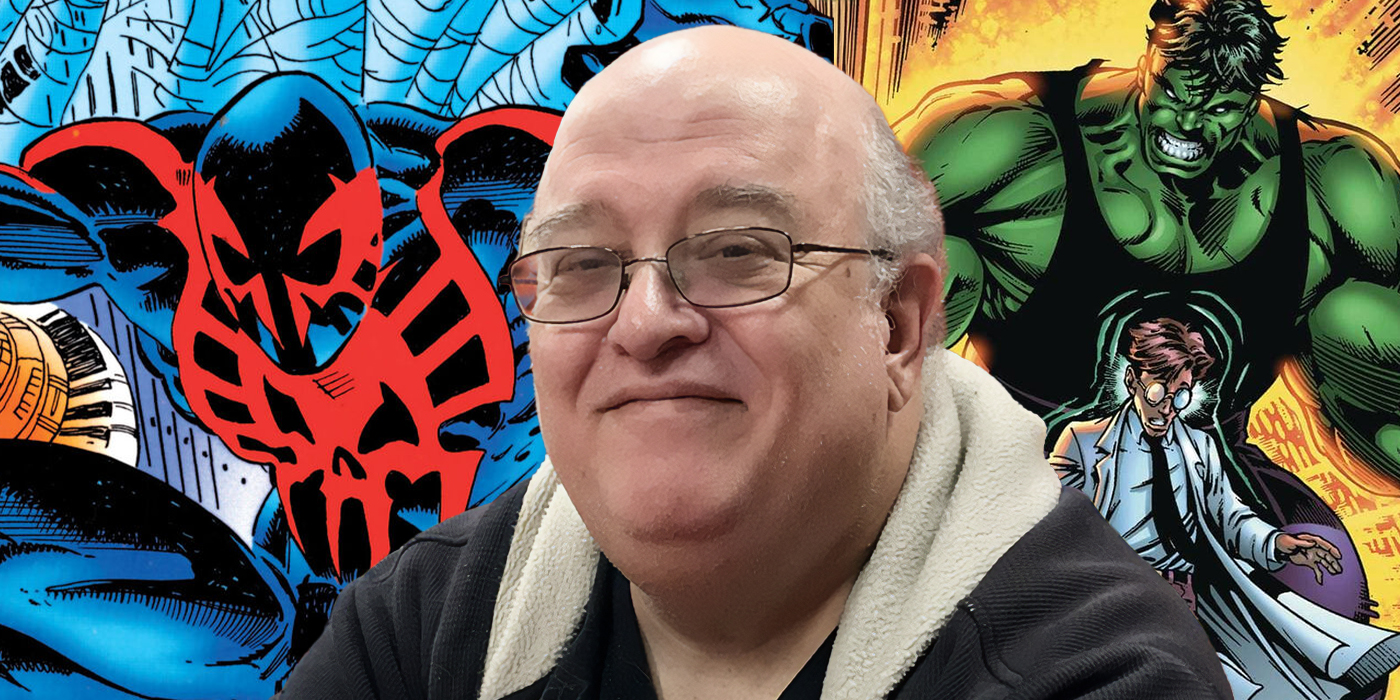
We lost comic book legend Peter David recently. David began working for Marvel Comics in the sales department, but he transitioned to editorial and began writing comics in the mid-80’s. As a comic book writer, novel writer, and even a television writer, Peter David’s talent can’t be overstated. He’s even got awards to prove it.
What made Peter David so unique was his respect for the characters he wrote for and ability to build upon their history. He’s known for his lengthy runs, many which ended up being considered the definitive takes on some iconic characters. Plus, the man knew funny. No one could write witty dialogue like Peter David. Here’s a top ten list of his greatest comic book runs and how his work expanded into other media.
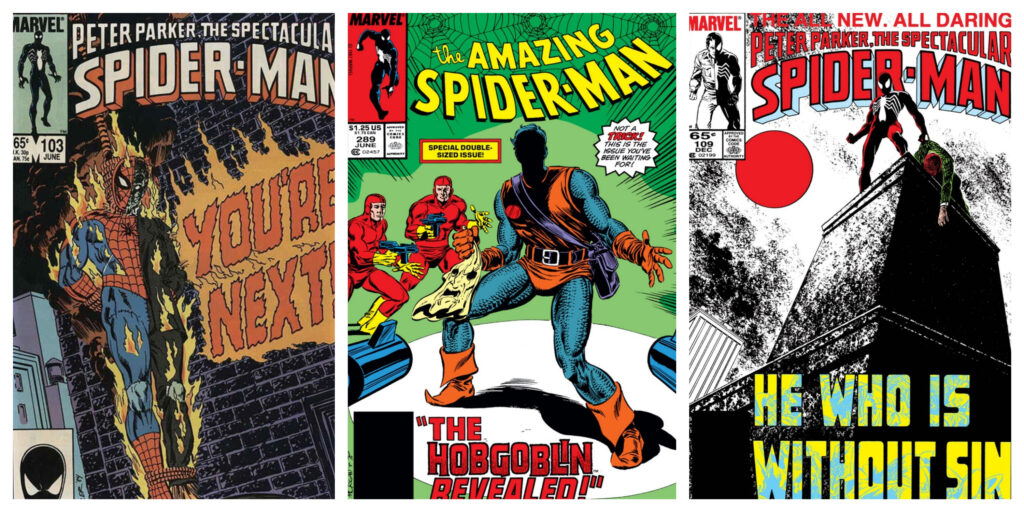
Peter David cut his teeth writing for Spider-Man. By the 1980’s, there were three ongoings – Amazing Spider-Man, Peter Parker the Spectacular Spider-Man, and Web of Spider-Man. David worked with many writers and artists, and although the stories at the time were collaborative, Peter David proved that he understood Spider-Man’s voice and humor.
Notable Issues – Peter David’s first writing credit was for Peter Parker, the Spectacular Spider-Man #103. He was also one of the writers who crafted the Hobgoblin mystery. His Death of Jean DeWolff (Peter Parker, the Spectacular Spider-Man #107-110) was an intense and haunting story that brought Spider-Man to the edge.
Legacy – Spider-Man The Animated Series was inspired by the Hobgoblin story, having a long drawn out arc that didn’t reveal his identity until much later. Jean DeWolff and Stan Carter were supporting characters on The Spectacular Spider-Man cartoon, but that series never made it to the Sin-Eater story.
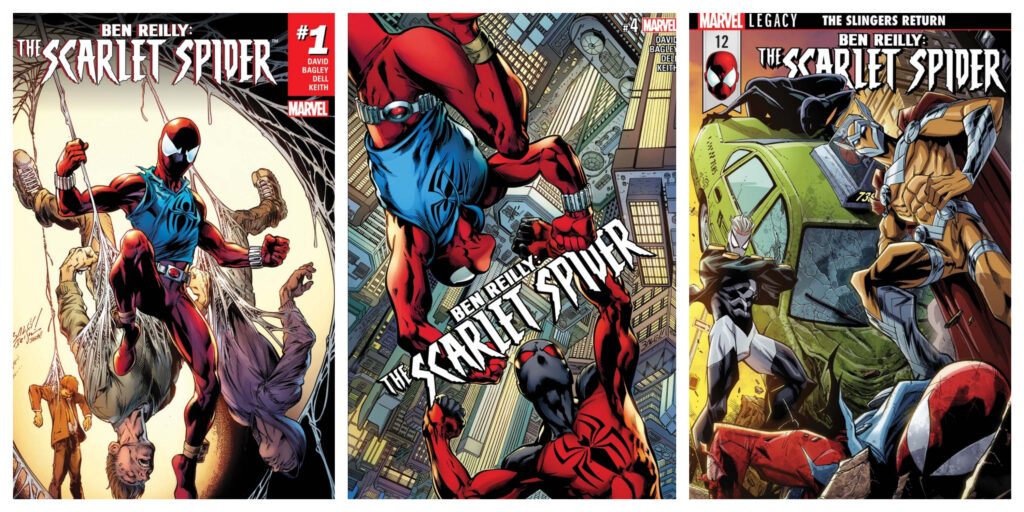
The aftermath of the 90’s Clone Saga briefly saw Peter’s clone take on a new identity of Ben Reilly while operating as the only Spider-Man. He was killed off so Peter could return, but Ben Reilly was brought back years later. Once again the Scarlet Spider, he had his own book written by Peter David. The series was more of a dark take on Ben, who had been traumatized by his death and resurrection.
Notable Issues – Given the nostalgia for 90’s Spider-Man, the brings back another Spider-Man clone, Kaine in #4-6, and the Slingers in #8-13.
Legacy – In a bit of brand synergy, while this Scarlet Spider series was running, the Ultimate Spider-Man cartoon’s fourth season featured Ben Reilly as the Scarlet Spider (although the comics didn’t influence the cartoon).
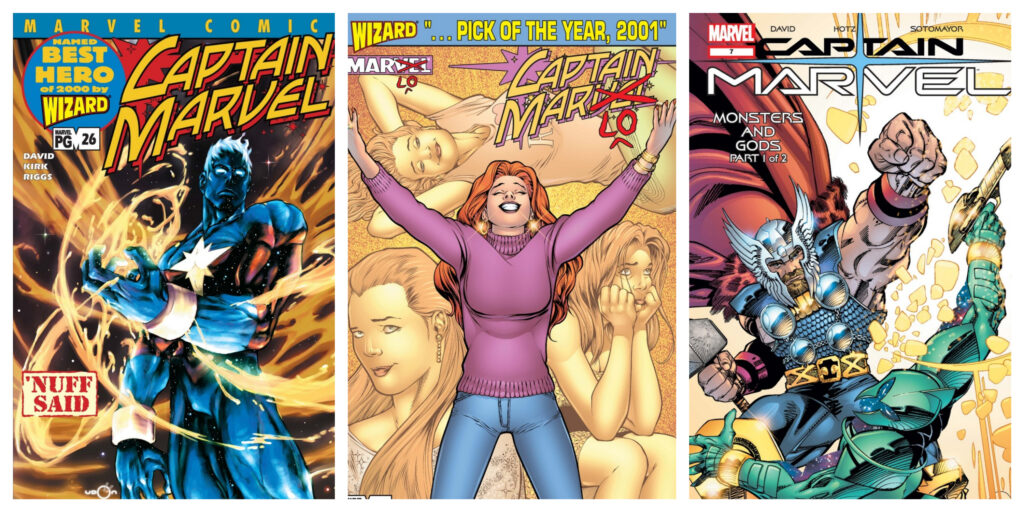
The original Captain Marvel, Mar-Vell, was killed in the 1980’s, and his legacy somewhat floundered. 1998’s Avengers Forever introduced a future version of Captain Marvel, who was Mar-Vell’s son, Genis. That mini-series spun Genis off into his own ongoing book with Peter David writing. Putting a new spin on the idea of Rick Jones bonded to a Captain Marvel, this series had the experienced sidekick Rick Jones training the novice hero. Both an epic cosmic story and a humorous adventure book, Peter David ended up in a contest called U-Decide with Bill Jemas and Joe Quesada as to whose book could sell better. Captain Marvel achieved a solid victory.
Notable Issues – Captain Marvel #26 was part of Marvel’s ‘Nuff Said event. There was no dialogue throughout the entire issue, and yet it was a compelling story. Captain Marvel’s cosmic awareness sent him over the edge during the beginning of volume 5, and the two-parter where he attacks Asgard claiming to be a god (Captain Marvel #7 and #8) was also really good.
Legacy – Possibly more notable than what he did with Genis was Peter David’s creation of Phyla-Vell, Mar-Vell’s daughter and Genis’ sister (Captain Marvel vol. 5 #16). A child version of her appeared in Guardians of the Galaxy Vol. 3, but it was the Guardians of the Galaxy cartoon series that had a more accurate version of her and turned her into both an antagonist and ally of the Guardians.
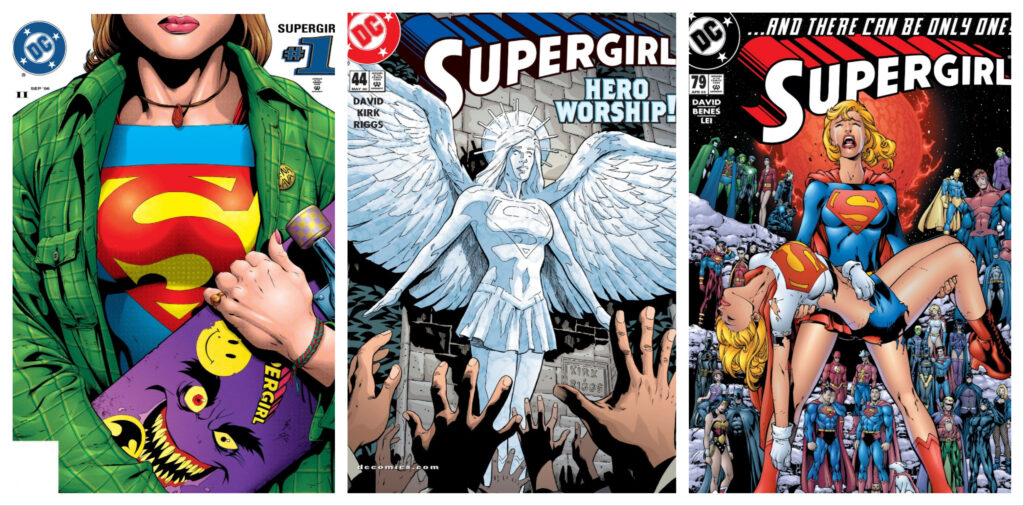
With Crisis on Infinite Earths having killed the Silver Age Supergirl, Peter David was given an interesting challenge in 1996 – create a new Supergirl from scratch. While he reimagined some classic bits of Supergirl lore, he substituted angelic powers and a supernatural backstory for her previous Kryptonian one.
Notable Issues – Given the many aspects that went into creating this new Supergirl and the struggle with identity, Supergirl #30 brings those themes to a head. Supergirl #50 was an epic battle in Hell. The grand finale which ties Supergirl lore together, “Many Happy Returns”, begins in Supergirl #75.
Legacy – The live action Supergirl TV series featured a Supergirl religious cult in season 3 similar to the one in David’s run. Oddly enough, the DCAU Supergirl wore a white costume on Superman The Animated Series while the comic still had her in the blue costume. The comic eventually incorporated the white costume, but soon after the series ended, DCAU Supergirl began wearing the blue costume on Justice League Unlimited.
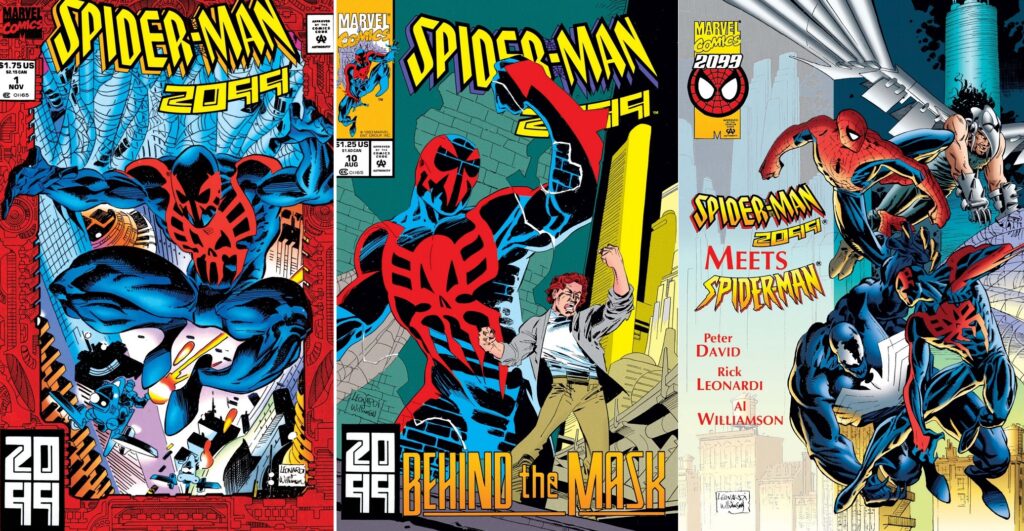
In the 90’s, Marvel rolled out a new line of comics that featured versions of their heroes in the year 2099. Naturally, there was a Spider-Man 2099. Real name Miguel O’Hara, Spider-Man 2099 was created by Peter David and Rick Leonardi. David wrote almost all of the initial run.
Notable Issues – Spider-Man 2099 #10 gave Miguel some much needed backstory and made him distinct from Peter Parker and a character in his own right. Spider-Man 2099 Meets Spider-Man was the long awaited crossover and features a cool Spider-Man 2099 vs. Venom fight.
Legacy – In the Ultimate Spider-Man cartoon, Spider-Man travels through various different realities and meets other versions of him. In “The Spider-Verse Part 1”, Spider-Man meets Spider-Man 2099 as the show shifts to 3D animation. Spider-Man 2099 played a huge role in 2023’s Spider-Man: Across the Spider-Verse.
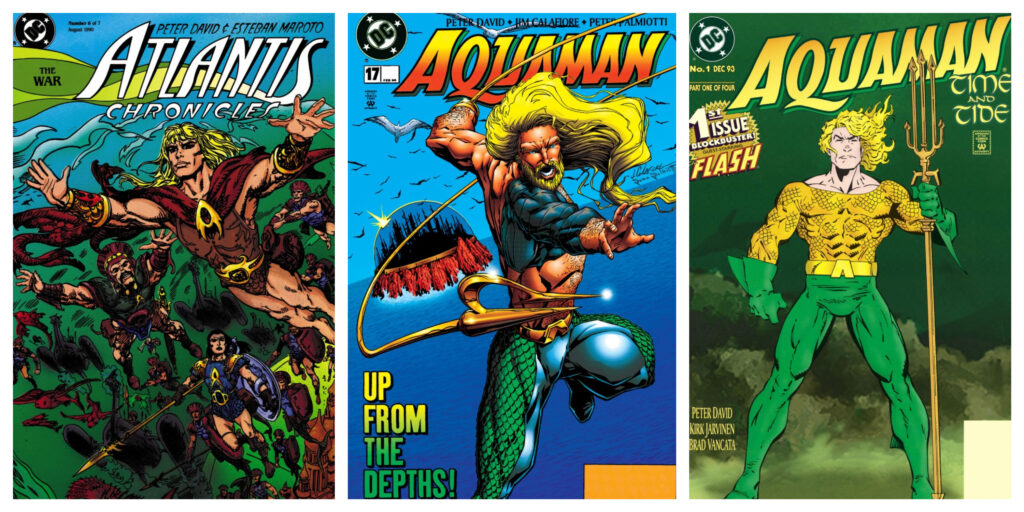
Created in 1941, Aquaman is the oldest character Peter David wrote for in a significant capacity. Much like with Supergirl, Peter David got a relatively clean slate to work on the character Post-Crisis. Prior to working on the main title, David wrote two mini-series, Atlantis Chronicles and Aquaman: Time and Tide. These were essentially to Aquaman and Atlantis what Batman: Year One was to Batman. Aquaman’s character was built from the ground up, and David added such touches as explaining where his Atlantean name “Orin” came from and giving his half-brother Orm aka Ocean Master claim to the throne. Not just a superhero, Peter David treated Aquaman as a mythic figure and a warrior king.
Notable Issues – In Aquaman #2, Aquaman loses a hand. This was the start of his redesign which included a beard, a new costume, and a harpoon for a hand. Issues #45 and #46 have Aquaman face ocean deities Poseidon and Triton and prove that he’s the king of the seas in a story that feels straight out of myth.
Legacy – The DCAU adapted the hook-handed Aquaman beginning with Justice League’s “The Enemy Below”, and his attitude largely reflected Peter David’s version of the character. The idea of Aquaman as a lost prince raised on land who has to return to rule the kingdom that is his by birthright and unite various undersea kingdoms was the basis of all live action versions of Aquaman, from the TV pilot with Justin Hartley to the Jason Momoa movies.
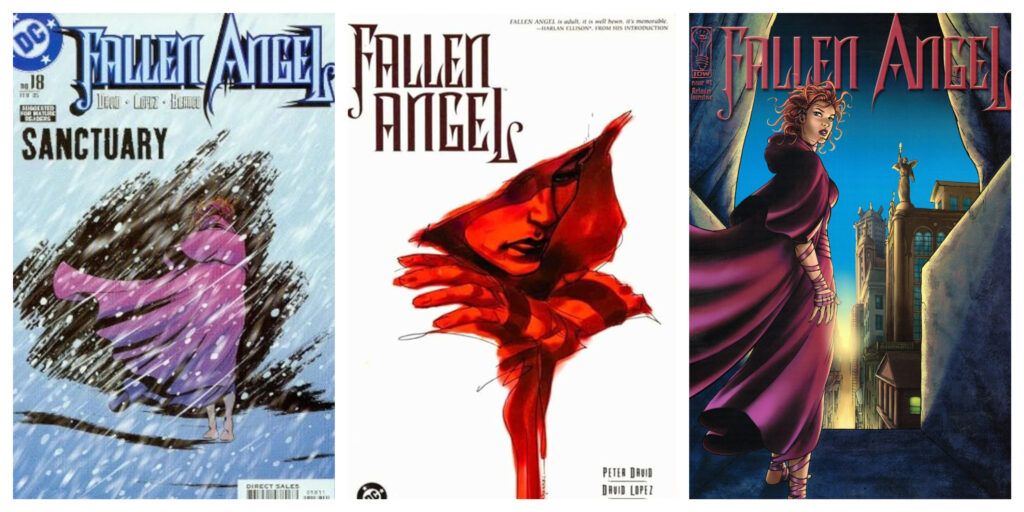
Unlike the other titles on this list, Fallen Angel was Peter David’s original creation. Not a superhero comic and not quite a Vertigo title, Fallen Angel was a mix of both that allowed Peter David to explore mature themes like free will, corruption, and Old Testament ideas. After DC canceled the series, David was allowed to continue it through IDW Publishing. The idea behind the series is that Liandra, a former guardian angel, has to fight the forces of evil in the city of Bete Noire, a city with a mystical and global influence.
Notable Issues – Issue #5 of the IDW run explains how God in this series works. He wants to sever ties with humanity but can only do so if they stop praying to Him. It had been long speculated that Fallen Angel was somehow tied to Supergirl, and issues #14 and #15 of the second volume finally explain the connection.
Legacy – Fallen Angel has yet to expand beyond the comic series. However, the series itself did have a crossover with Angel (as in the TV show spun off from Buffy the Vampire Slayer) and Shi.
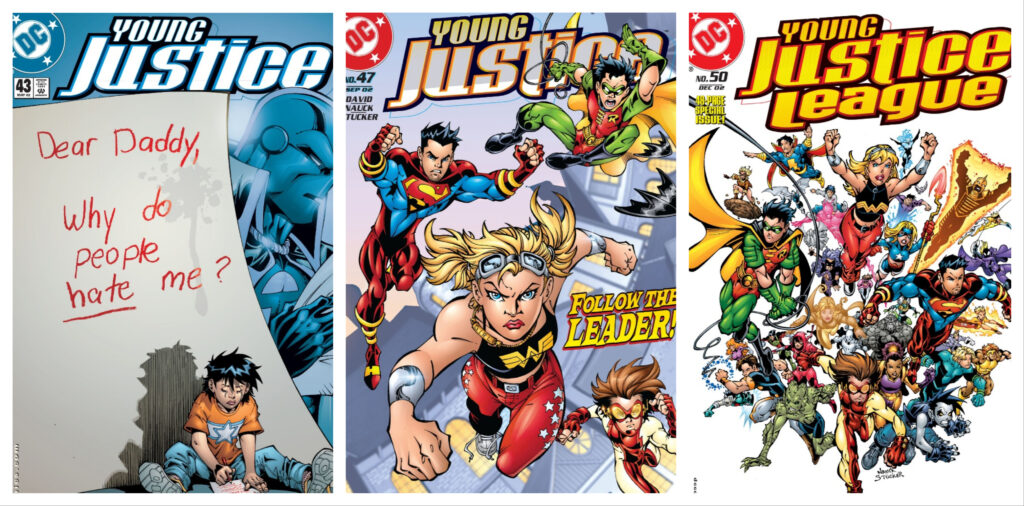
The Teen Titans exploded in popularity in the 1980’s, but by the 90’s, the new heroes that made up the Titans weren’t selling as well. Peter David went back to basics by creating Young Justice, a team of young counterparts to the Justice League. Things were a little different than the Teen Titans, as three leads of Young Justice (Robin, Superboy, and Impulse) had their own titles. David’s book maintained tight continuity, honored the legacy of the Teen Titans, hit on some serious themes, and was absolutely hilarious. Young Justice did a better job serving that current generation of young heroes (so post-Dick Grayson pre-Damian Wayne) than the Teen Titans series that continued their adventures in 2003.
Notable Issues – The very first issue had Peter David poke fun at himself by having each hero dream themselves in the role of a previous hero David had written for (Robin was Aquaman, Impulse was Hulk, and, naturally, Superboy was Supergirl). The book did humor (meeting Old Justice in Young Justice #16). The book did prejudice (Red Tornado’s daughter attacked by her classmates because of her place of birth in Young Justice #41). The book did action (assembling dozens of teen heroes in Young Justice #50). Peter David even let the fans vote on who they wanted to be the new team leader (Wonder Girl won as revealed in Young Justice #47).
Legacy – While the Young Justice cartoon of 2010 borrowed from all eras of DC’s history, bits and pieces were influenced by Peter David’s title. David himself penned five episodes, including “Secrets”, which featured characters he created in the comics, Secret and Harm.
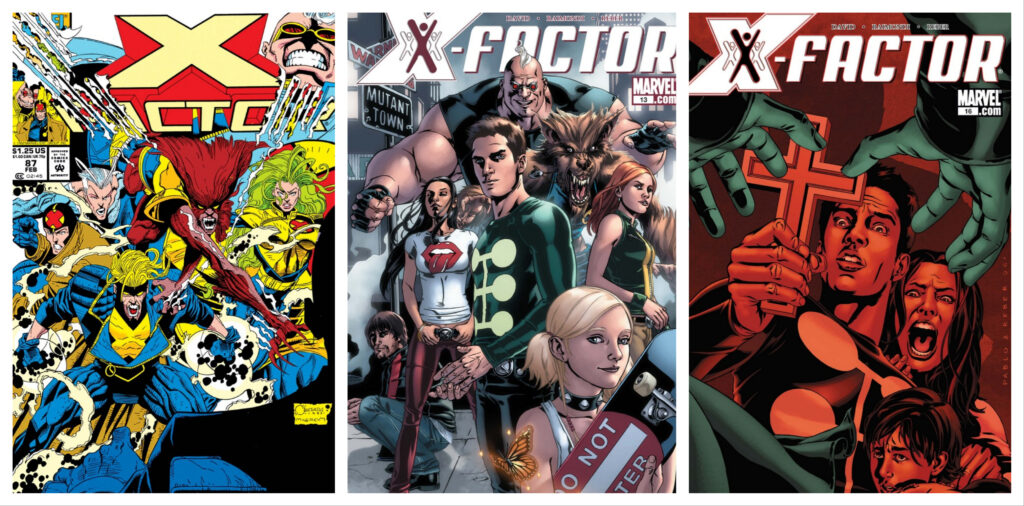
X-Factor began as a book for the original five X-Men, but when a new team roster appeared, Peter David was brought on to make stars out of secondary X-Men characters. The run was short but memorable, and David outdid himself when he returned to the rebooted book in 2005. His final stint on X-Factor, called All-New X-Factor, reimagined the team as being sponsored by a corporation, rather than the government. Throughout all his runs, David was, again, consistent with characterization, humor, and surprise twists and turns. He formed definitive versions of these characters, especially Jamie Madrox/Multiple Man. David used the idea of a mutant who could create duplicates of himself and wrote some truly thought provoking stories of introspection.
Notable Issues – X-Factor #87 saw each member of X-Factor talking to a psychiatrist (later revealed to be Doc Samson), and while it had very little action, it was a compelling look at well developed characters. David re-used this idea in X-Factor vol. 2 #13, and it worked just as well. Issue #16 of that series had Madrox meet one of his dupes that started his own life and had a family. It was amazing how much sympathy David created for a manifestation of the Multiple Man’s power.
Legacy – Peter David’s X-Factor showed up in the X-Men The Animated Series episode “Cold Comfort”, although they weren’t given much personality. Multiple Man appears in X-Men: The Last Stand, wearing the shirt he wore in volume 2 of X-Factor. He didn’t get much focus either, but it’s arguable that there was some of Peter David’s Jamie Madrox in him. Peter David’s second X-Factor run dealt with Polaris coming to terms with Magneto being her father, which was a major part of Polaris’s character growth on the TV show, The Gifted.
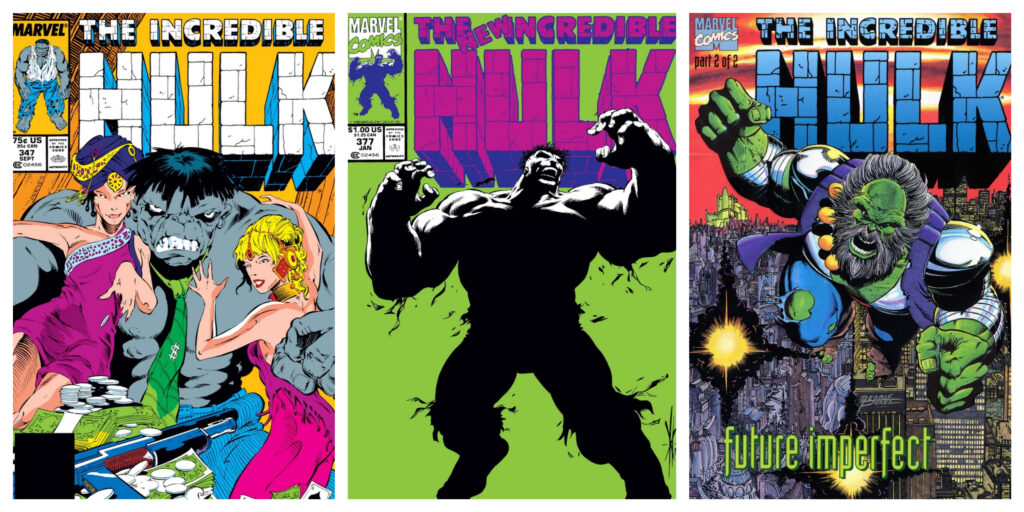
Peter David’s definitive comic book run is, arguably, also the definitive Incredible Hulk run. Lasting a phenomenal 12 years, David explored the character in ways no one has before and set the standard for how to treat the Hulk. David used the idea that childhood trauma fragmented Bruce Banner’s psyche. So there wasn’t just a savage Hulk inside him, there were other personalities and forms of the Hulk to explore. David brought back the idea of there being a grey form of the Hulk, but his Grey Hulk was a morally ambiguous Las Vegas mobster named Joe Fixit. David would later have all Hulks unite as Doc Samson helps Banner gain more control over himself. This Smart Hulk (or Professor Hulk) would remain throughout almost the entire run. Although Banner would still struggle to maintain control, and he eventually met his dark future self, the Maestro.
Notable Issues – Incredible Hulk #347 began Grey Hulk’s journey into becoming Joe Fixit. The Smart Hulk story was Incredible Hulk #376 and #377. Maestro initially appeared in the Incredible Hulk: Future Imperfect special. Peter David wrote two finales – The Incredible Hulk #467, a story ten years in the future where Rick Jones reflects on the Hulk’s life, and Hulk: The End, a story in the far future where the only sentient being left on Earth is Hulk/Bruce Banner.
Legacy – Peter David’s fingerprints are all over every post-80’s version of the Hulk. Joe Fixit appears in the Incredible Hulk The Animated Series episode “They Call Me Mr. Fixit” and Ultimate Spider-Man‘s “Return to the Spider-Verse Part 3”. Hulk and the Agents of S.M.A.S.H. essentially starred the Professor Hulk version of the character, and The Maestro appeared in the episode “Enter, the Maestro”. The MCU finally introduced Professor Hulk in Avengers: Endgame.
All that, and I haven’t even mentioned his Star Trek novels or his book series Sir Apropos of Nothing or the much too short lived Nickelodeon sci-fi series Space Cases. Or the dozen or so superhero movies that gave Peter David a special thanks in the end credits. Or the Hell on Earth War he teased in Incredible Hulk but then paid off years later in X-Factor. Or him often using “Grozit!” as an alien expletive across various works. I could go on much longer, but you don’t need to read more about Peter David. You need to read more Peter David.
Discuss this article on the Toonzone Forums!
The post Peter David – His Greatest Comic Book Runs and His Legacy appeared first on Anime Superhero News.